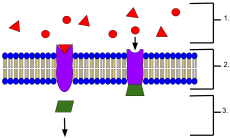

Desensitisation of the receptor is when there is decreased responsiveness that occurs following repeated exposure to agonist. Tachyphylaxis is the inability of tissues and organs to respond to a stimulus. When agonist stays bound to receptor this can cause receptor modification (phosphorylation), the receptor being internalised (what happens when a drug binds to receptor), exhaustion of mediators or physiological adaption (homeostatic response.)
There are various clinical uses for agonists: for example, adrenaline and dopamine to increase heart rate and morphine for pain relief. The clinical use of partial agonists is to not block basal activity but reduce over-activity.
Inverse agonists are those that bind to the same receptor as agonists but induce a pharmacological response opposite to that of agonists. Many antagonists are in-fact inverse agonists. Many G protein receptors are active in the absence of ligand (activity most likely too low to be important in physiological states), but inverse agonists bind and reduce this activity. The GABAA receptor is an ion channel that requires GABA binding for the channel to open. Benzodiazepines (a drug) increase opening through binding to receptor. Inverse agonists decrease this opening.
Antagonists are drugs that have 0 efficacy and stop the agonist from binding.
Competitive receptor antagonists have various clinical uses. For example, naloxone is used as an opiate receptor antagonist. It binds to the opiate receptor to help addicts deal with addiction by tackling the ‘cold turkey’ (withdrawal symptoms), whilst not giving the high that one gets from opiates. It can also be used with Buprenorphine, a partial agonist that helps with addiction by lowering the dose but treating the withdrawal. Naloxone blocks the activity of buprenorphine. Beta blockers are antagonists used for heart arrhythmias and anxiety as well as hypertension. They work by lowering the heart rate.
The greater a receptor or ion channel is activated the greater amount needed to block it. Why is this good? Well it ensures basal activity can be preserved without receiving over-activity. Examples of over-activity can be epilepsy, hypertension and cardiac arrhythmias.
The nervous system is firstly divided into the central and peripheral. The central nervous system consists of the brain and spinal cord. The peripheral nervous system is all the nerves that link the central nervous system to the rest of the body. Information is carried by nerve fibres that can be afferent or efferent. Afferent fibres carry sensory information to the central nervous system. Efferent fibres carry signals from the central nervous system to the peripheral nervous system. The dorsal horn of the spinal cord carries sensory inputs and the ventral horn carries somatic motor neurones.
A synapse is a junction where a presynaptic neurone transmits a signal to postsynaptic neurone across the synaptic cleft (involving neurotransmitter and receptors). This can be simplified into 5 easy steps:
Step 1 is synthesis. Neurotransmitter has to be synthesised in order to be transmitted.
Step 2 is storage of this transmitter we have just made, we need to package and protect it, this allows the neurotransmitter to be packed at high quantities.
Step 3 is release of the neurotransmitter (involving docking of vesicle, fusion of vesicle (exocytosis) releasing neurotransmitter and recycling of transmitter by endocytosis).
Step 4 is when the neurotransmitter binds to receptors on the postsynaptic neurone and activate it.
Step 5 is inactivation, this requires enzymes and glial cells.
Image- https://en.wikipedia.org/wiki/Receptor_(biochemistry)

0 Comment:
Be the first one to comment on this article.